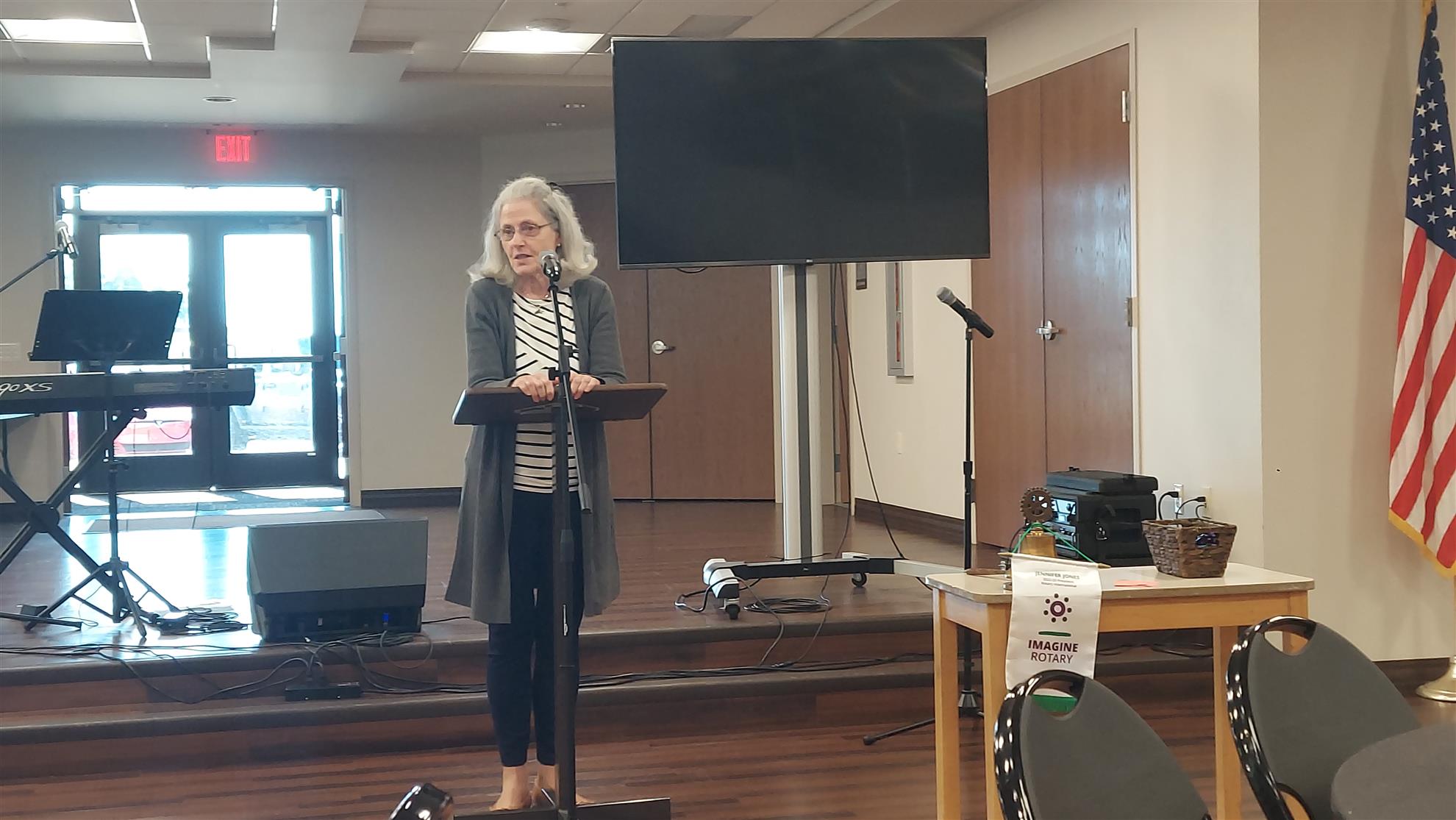 In recognition of World Polio Day, Rotary heard from Sonny Wilkinson and Dr. Linda Thompson, PhD, with the Oklahoma Medical Research Foundation.
In recognition of World Polio Day, Rotary heard from Sonny Wilkinson and Dr. Linda Thompson, PhD, with the Oklahoma Medical Research Foundation.The October 27, 2022 meeting of the Rotary Club of Chickasha was called to order by President Lewis Knisley. Rot. Mitch Williams led the club in singing "Smile and the World Smiles With You".
Pres. Knisley delivered announcements:
- On the 24th, Rotarians met to help with assembling the new clothes closet at Bill Wallace Early Childhood Center, but the work was not completed. A time is being arranged to reconvene and finish setup.
- If you are able to help, contact Pres. Knisley.
- The Rotary Roll Call assembly at Lincoln Elementary would be held immediately after the meeting.
- The Christmas Party is tentatively planned for December 12, 6pm, at The Club.
- The board is looking for committee members to carry out the event. If you are interested, please contact the board.
Pres. Knisley, standing in for Rotarian of the Day Jason Jarnagin, introduced the week's speakers from the Oklahoma Medical Research Foundation. OMRF was invited to speak in recognition of World Polio Day and Rotary International's efforts to combat polio worldwide.
Sonny Wilkinson, Senior Director of Development and Planned Giving, showed a video to explain OMRF and its mission.
After the video, Dr. Linda Thompson, Ph.D., began the presentation. Dr. Thompson was born in Cincinnati, Ohio. She was the second person in her family (both sides) to attend college. She went to The University of Michigan for both undergraduate and graduate school and earned a Ph.D. in Biological Chemistry in 1973. Her first “science” job was baking and tasting cakes for Duncan Hines, a division of Procter and Gamble (headquarters in Cincinnati). That job convinced her that she needed an advanced degree. After graduate school, Dr. Thompson taught freshman chemistry and biochemistry at UNLV in Las Vegas. She then went on to postdoctoral training at UCSD where she studied inherited immunodeficiency diseases. Upon completion of her postdoctoral work, she joined the faculty of Scripps Clinic and Research Foundation in La Jolla, California. After 9 years, Dr. Thompson moved to Oklahoma in 1989 and joined OMRF. At OMRF, she is in the Arthritis and Clinical Immunology Department and also serves as in adjunct faculty appointment at OUHSC in the Department of Microbiology and Immunology. Her current research is about the autoimmune disease Sjögren’s Syndrome and the immune response to SARS-CoV-2 infection and vaccination. She spends a large part of her time mentoring young faculty members.
Her outside interests include cooking, gardening, reading, working out, and traveling (especially to our National Parks). She is a huge fan of the Michigan Wolverines and the OKC Thunder.
Her outside interests include cooking, gardening, reading, working out, and traveling (especially to our National Parks). She is a huge fan of the Michigan Wolverines and the OKC Thunder.

The first part of Dr. Thompson's presentation explained polio in general. Polio is caused by a highly contagious virus that is spread through contact with feces or very rarely through airborne droplets, and enters the body through the mouth. 3 in 4 people who contract the virus have no symptoms at all. 1.5 percent of those infected develop meningitis, and 0.5 percent develop paralysis.
There are two basic types of polio vaccine. The inactivated polio vaccine (IPV) is the one used in the United States and is administered by injection. It is impossible to contract polio from the IPV. The oral polio vaccine (OPV) is much easier to administer, especially to large groups of people and in rural or underdeveloped areas. However, very rarely (1 in 750,000 cases) the OPV may reactivate and cause paralytic polio.
The vaccine has been extremely effective: in the 1950s, before the introduction of the vaccine, there were 15,000 cases of paralytic polio in the U.S. After the vaccine was introduced, cases dropped to 100 in the 1960s and just 10 in the 1970s. Polio was eradicated in the Americas by 1994, several western Pacific nations by 2000, Europe by 2002, southeast Asia by 2014, and Africa by 2020. However, between 2016 and 2021, global polio cases still ranged from 42 to 2100 a year. Polio is still considered endemic in Afghanistan and Pakistan.
A major step towards the complete eradication of polio will be to phase out all use of OPV in favor of IPV, but this process will take at least 5 years.
Afterwards, Dr. Thompson spoke on vaccines in general, especially the flu and COVID-19 vaccines. The following vaccinations are recommended for adults:
- Influenza – every year
- Tetanus – 1 dose Tdap, then Tdap or Td booster every 10 years
- Measles/mumps/rubella – 1-2 doses if born in 1957 or later (usually given in childhood)
- Varicella (chickenpox) – 2 doses if born in 1980 or later
- Zoster (shingles) – 2 doses if 50 years or older
- HPV – 2-3 doses if younger than 27
- Pneumococcal – 1 does PCV15 followed by PPSV23 or 1 does PCV20 if 50 or older
- Hepatitis B – 2-4 doses depending on vaccine if 59 or younger
- Covid-19
Dr. Thompson did not give a specific timeline for Covid-19 boosters, but in response to a member question she stated that the effectiveness of the vaccine was reduced to one-third by six months after initial vaccination. She also said that the newest boosters are designed for the newest strains (similarly to the annual flu vaccine)—the latest booster is far more effective against the Omicron variant, which accounts for 98% of cases in Oklahoma.
Catering was provided by Rock Island Grill.